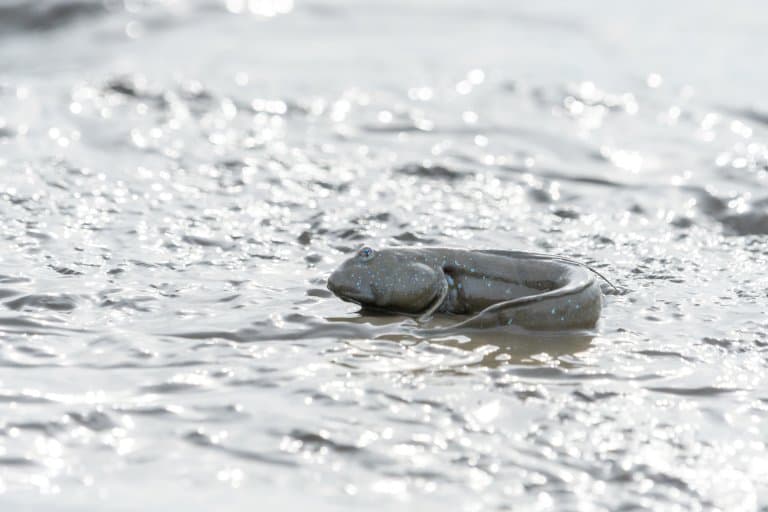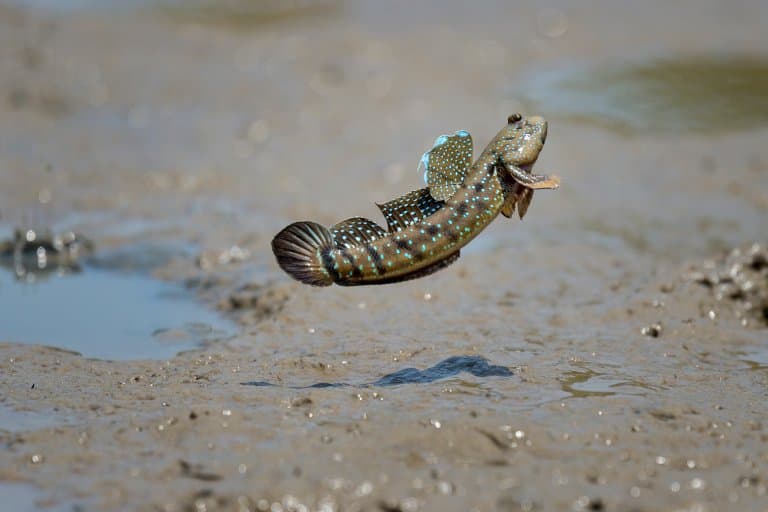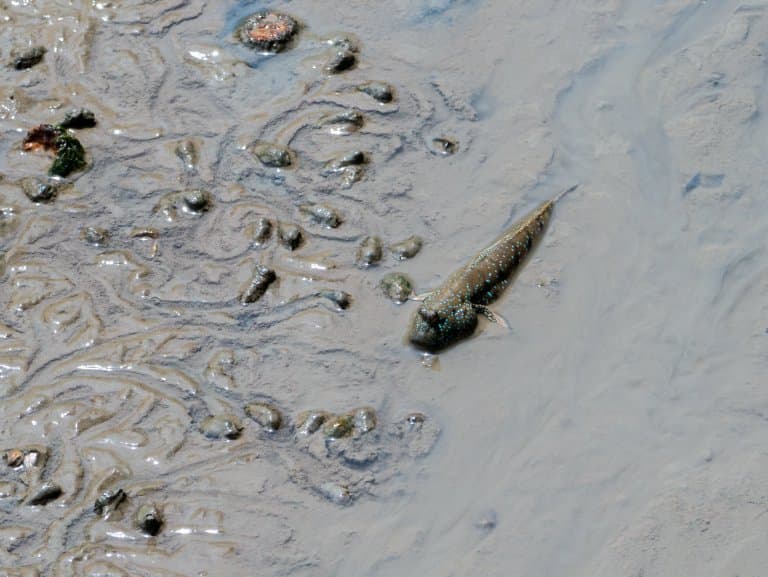Mudskipper Profile
Somewhere around 390 million years ago, Devonian fish species began a transition between aquatic and terrestrial life forms.
It was roughly this time that the ancestor of all tetrapods, including humans, waddled out of the depths and into the muddy flats to learn how to walk.
From there, all land vertebrate species radiated, from snakes to panthers, wagtails to Wim Hof. This transition happened relatively fast, over perhaps 16 to 20 million years, and about 150 million years later, another branch of fish began the process.
Mudskippers are a type of amphibious fish, with a total of 23 extant species that inhabit semiaquatic environments primarily in Australia, as well as Polynesia, Africa, and Southeast Asia.

Mudskipper Facts Overview
| Habitat: | Mud flats of swamps and estuaries |
| Location: | Mostly Australia, also Polynesia, Africa, Southeast Asia |
| Lifespan: | Over 5 years in captivity |
| Size: | Up to 30cm (12 inches) |
| Weight: | Around 50g |
| Color: | Grey/brown with mottles and decorated fins |
| Diet: | Small crustaceans |
| Predators: | Shorebirds and snakes |
| Top Speed: | Unknown |
| No. of Species: |
23 |
| Conservation Status: |
All Recorded are Least Concern (IUCN) |
Mudskippers aren’t tetrapods or even ancestors of tetrapods. They’re actually from one of the other two lineages of fishes the tetrapod ancestors branched off from about 530 million years ago.
They have evolved some interesting traits that we think resemble some of the earliest tetrapod movements.
They are remarkably well-adapted to life out of the water, though they need to stay very close to it.
They skip, flip, roll and dig in it, and they teach us many things about how we may have once dragged our flappy bits out of the water and onto land.
Interesting Mudskipper Facts
1. They spend a lot of time on land
This is a bit strange for fish, who are typically known to prefer wetter environments. But mudskippers have developed incredible adaptations that allow them to escape their watery prison and flap about on the mud that’s left at low tide.
And it’s not the first time this has happened. All of us land vertebrates came out of the ocean at some point. Some of us, like whales, went back in later, but we’re all essentially sarcopterygian land fish, more closely related to a coelacanth than a coelacanth is to a herring.
Technically this makes dolphins aquatic land fish, but that’s another story. In fact, we haven’t distanced ourselves from the ocean as we may think.
As humans, we still very much need daily water intake to survive, and a ratio of salts within it that closely resemble the chemical makeup of the ocean from which we came. Mudskippers, while not related to our transitional ancestors, do mirror our transition from aquatic fish to terrestrial vertebrates.
And they share some interesting characteristics with what we see from our ancestors in the fossil record.
2. They have shoulders
One of the key features of tetrapod ancestors and the remaining sarcopterygians is the ability to rotate their shoulder joints. This likely led to our ancestors dragging their limp, fishy bodies across the ground as if someone just tipped them out of a wheelchair after a hip surgery.
Ray-finned fish don’t usually have this joint, but mudskippers have a very close equivalent. This allows them to pull themselves along, something which corroborates the recent idea that our ancestors used front-wheel drive, instead of a more salamander-like rear-limbed pushing motion. 1
3. They can breathe air
So, you’re a fish with biceps and you’ve made it out of the water. That’s all well and good, but did you think about breathing?
Mudskippers did. They have permeable membranes for gas exchange inside the lining of their mouths and throats. Essentially, they can breathe through their skin.
So, when out of the water, mudskippers can be seen gulping big mouthfuls of air and holding it, the same way you see people in the park do when they’re about to pick up their dog’s poo in one of those baggies and take it to the bin.
But instead of holding their breath, this is actually how they breathe on land. This method works well, as long as the gill chamber the air is in remains wet. So, they’re quite limited to how dry their environment can become. 2

4. Mud flippers
Mud skippers, despite their slimy environment, are capable of incredible glamour. When trying to attract a mate, they put in an incredible show with long and intricate dorsal fins and displays of strength and agility.
These demonstrations take the form of great leaps into the air or ‘skips’ (as their name implies), during which their sail-like fins are displayed.
But it’s not just for courtship; this acrobatic artistry also wards off competitors. Or at least it’s supposed to. But fights are common, and rival males will often interrupt the courtship – or even the coitus – of a prospective suitor.
Fights are often comical, open-mouthed affairs, usually limited to intimidation and a bit of flailing. 3

5. Mud rollers
And since they have thin and sensitive fish skin, they’re also in danger of sunburn while out on the mudflats. To combat this, like many mammals, they roll about in the mud to give themselves a protective sheen.
This skin has a higher resistance to terrestrial pathogens such as bacteria and parasites than that of their submerged kin; another special adaptation to land living.
6. Mud diggers
To avoid predation, they dig burrows. These are typically J or Y-shaped tubes in the mud that are dug out by mouth and are thus surrounded at the surface by little bricks of mud, formed from the mud spat out during the creation of the burrow.
Mudskippers retreat into these burrows backwards and poke their little googly eyes out the top to look around.
These eyes are well-adapted to terrestrial life, too, and can see a lot farther in the air than other fish. They also have a sense of smell that is specialised for aerial olfaction, rather than aquatic, and use this to hunt and navigate, as well as detect danger.
Eggs are laid in these burrows, and guarded by both parents after fertilisation. All of these adaptations lend themselves to a much drier environment than their fishy cousins, but there are other things preventing them from evolving farther onto land.
7. They dine on the mudflats
Tiny plants and animals flourish on the ground known as mudflats, which is where the tide retreats into the sea and exposes a silky mud and sand terrain.
Some mudskipper species will diet on insects, snails and crabs, while others are detritivores, and will suck up decomposing plant and animal matter from the mudflats.
8. They evolved the ability to blink
While this doesn’t sound very impressive, actually other aquatic goby species do not have the ability (or need) to blink.
The mudskipper is thought to have evolved the ability to blink due to terrestrial conditions and to allow it keep their eyes wet out of water.

9. They probably won’t fully transition
We mentioned that these fish represent a potential transition, but evolution doesn’t work in a conscious direction, and just because it happened once, doesn’t mean it will happen again.
Time isn’t the only thing mudskippers would need to morph into briefcase-wielding bureaucrats; when our lineage did it, the land was relatively bare. There were opportunities and resources to exploit and niches to fill.
Over the 390 million years since our slippery ancestors flopped onto land, they’ve occupied most of these niches.
This makes it very unlikely that mudskippers will follow a similar path in their evolution. That is, unless significant environmental changes favour their chances.
So, if global warming somehow wipes us out and miraculously saves the mudskippers, they may be next in line for land dominance. Otherwise, they’re likely to stay in the mud while we take up all the space on land.
Mudskipper Fact-File Summary
Scientific Classification
| Kingdom: | Animalia |
| Phylum: | Chordata |
| Class: | Actinopterygii |
| Order: | Gobiiforms |
| Family: | Oxudercidae |
| Subfamily: | Oxudercinae |
| Genera: | Apocryptes Apocryptodon Boleophthalmus Oxuderces Parapocryptes Periophthalmodon Periophthalmus Pseudapocryptes Scartelaos Zappa |
Fact Sources & References
- Zachary M. G. Quigley, Richard W. Blob, Sandy M. Kawano (2022), “Kinematic comparisons between mudskipper fins and salamander limbs during terrestrial locomotion“, Wiley Online Libraty.
- Mariko Kurita, Shohei Noma, Atsushi Ishimatsu (2021), “Morphology of the respiratory vasculature of the mudskipper Boleophthalmus pectinirostris (Gobiidae: Oxudercinae)“, Wiley Online Library.
- “Life in the Mud, Mudskipper“, Oceanographic Magazine.
